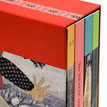| David Ebony |
NATURAL FORTITUDE:
GRAHAM SUTHERLAND IN BRITAIN |
Today, with global warming and other environmental changes heading
most people’s must-deal-with list, the work of Graham Sutherland
(1903–1980) has an ever more profound significance. Especially pertinent
to the trials and tribulations of virtually all 21st-century life forms, not
to mention universal angst over fragile Earth’s apparent malaise,
Sutherland’s special view of nature rewards close and frequent examination.
Most critics regard as his purest expression of nature’s relentless
struggle the brooding images of rugged landscapes and gnarled organic
forms that he produced in England and Wales prior to the early 1950s. By
1955, the sirens of fame and fortune had summoned the London-born
painter to reside permanently in the balmy environs of the Côte d’Azur.
Sutherland’s richly impastoed, brilliantly colored paintings and works
on paper of the 1930s and ’40s are visual metaphors for survival. They
contain fierce renderings of forms found in nature that have successfully
battled the elements, though just barely. These pictures of contorted roots,
thorn trees and ravaged coastlines are quite unlike anything produced in
Britain at the time. Similar in impact to Henry Moore’s contribution to
sculpture, Sutherland’s achievement in painting was unrivaled in Britain
during this period. Canvases such as Green Tree Form: Interior of Wood (1940), Horned Forms (1944), and Thorn Head (1947), recall comments by the eminent English critic Herbert Read, who said of Sutherland’s
work of the period, “. . . the growing fearsomeness of the symbols
reflects the now prevailing cosmic anxiety.”1
Sutherland had an early ambition to become an engineer but was
thwarted by inadequate math skills. He studied at Goldsmiths and was
inspired by Blake and Turner, and especially by the visionary works of
Samuel Palmer. At Goldsmiths he met Kathleen Barry, a fashion designer
who he married in 1927, and remained with for the rest of his life. Tragedy
struck the couple early on in their marriage when their only child, a son,
died a few days after birth. In the following year, they spent considerable
time exploring Kent, the verdant countryside southeast of London that
Palmer had transformed in his work to a mystical and magical realm.
Eventually the Sutherlands bought a house there.
Graham began his career as an etcher and achieved considerable success
with small, densely packed compositions with nostalgic and quasi-mystical
overtones, such as Cray Fields (1925) and Pastoral (1930), borrowing heavily
from Samuel Palmer’s work. In Cray Fields, the exaggerated rays of
light streaming though the trees allude no doubt to a rapturous morning
exaltation. Similarly moving, Pastoral shows plant and tree forms inhabiting
a bucolic setting, yet they appear wildly exaggerated and transformed into
towering and menacing creatures.
After the once-lucrative print market collapsed during the Great
Depression in the early 1930s, Sutherland assumed a teaching post at the
Chelsea School of Art and also took on design work including posters, textiles,
china and glassware. Inspired by a chance 1934 visit to Wales, he
began to work in oils. The young painter was transfixed by the extraordinary
landscape of the Welsh coastline, where high winds and harsh terrain
allow only the hardiest of life forms to survive. Here began his lifelong
study of metamorphosis and his fascination with organic forms whose
mangled shapes reflect the struggle of every living thing to withstand the
violent forces of nature. Of Wales, Sutherland said, “It was in this country
that I began to learn painting … I felt I could express what I felt only by
paraphrasing what I saw. Moreover, such country did not seem to make
man appear little as does some country of the grander sort. I felt just as
much a part of the earth as my features were part of me. I did not feel that
my imagination was in conflict with the real, but that reality was a dispersed
and disintegrated form of the imagination.”2
During his early Welsh period, he produced numerous works on paper,
including Landscape Study at Cairns (1937) and Tree Form in Estuary (1945), whose overwrought surfaces of harsh but eloquent lines, and acidic yet
engaging tones in gouache further convey a strong feeling of anguish and
struggle. Here also is more than a hint of redemption.
One of Sutherland’s key early works, Red Monolith (1938) corresponds
to the experiments of Unit One, a loose affiliation of artists with whom
Sutherland often exhibited, including Henry Moore, Ben Nicholson,
Barbara Hepworth, Paul Nash and Victor Pasmore. Sutherland’s spare
abstraction, based on a rock formation, demonstrates the artist’s interest in
ambiguous spatial relationships, which preoccupied him throughout his
career. Here, a totemic stone rendered in orange-pink features a dark cavity
at the top and tapers to two points at the bottom. Set against a simple background
of dark blue and ocher, the composition suggests both microcosm
and macrocosm. The richly textured geometric shapes and reductive ground recall certain works by Nicholson, while the fractured landscape
elements hint at Nash.
1. Herbert Read: A British Vision of World Art, Benedict Read and David Thistlewood eds.,
London, Lund Humphries, 1993, p. 88.
2. Graham Sutherland, “Welsh Sketch Book” in Graham Sutherland: Landscapes, War
Scenes, Portraits 1924-1950, by Martin Hammer, London, Scala, 2005, p. 70.
—
DAVID EBONY is currently Managing Editor of Art in America magazine. He
is also Contributing Editor and writer for Lacanian Ink. Among his books are
Emily Mason (Braziller, 2006); Botero: Abu Ghraib (Prestel, 2006); Craigie
Horsfield: Relation (Jeu de Paume, 2006); and Carlo Maria Mariani (2002). He
lives and works in New York City.
For the complete article purchase The
Sienese Shredder #3
Back to The Sienese Shredder #3
| 

